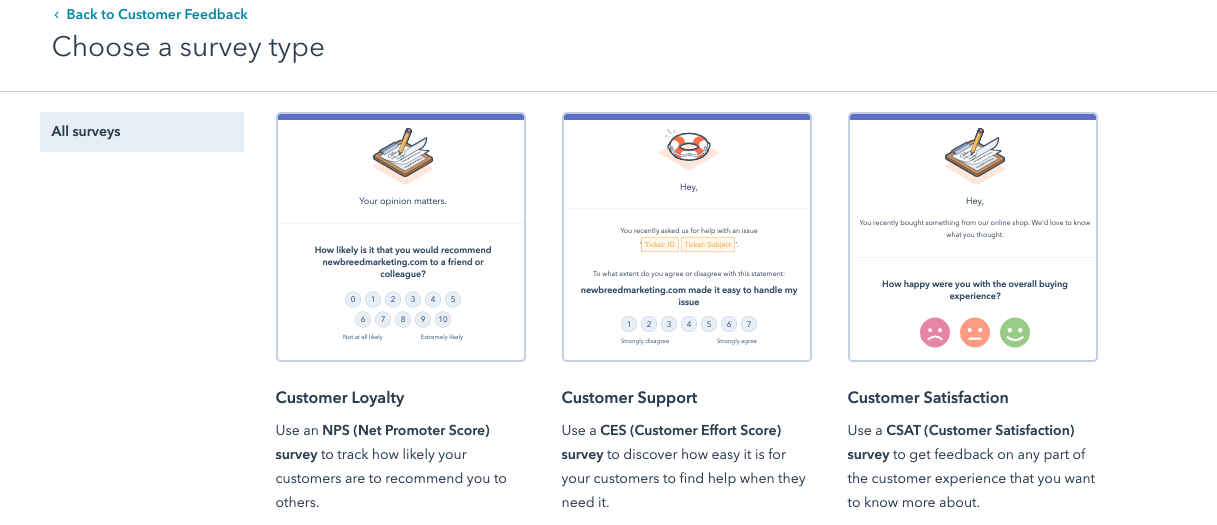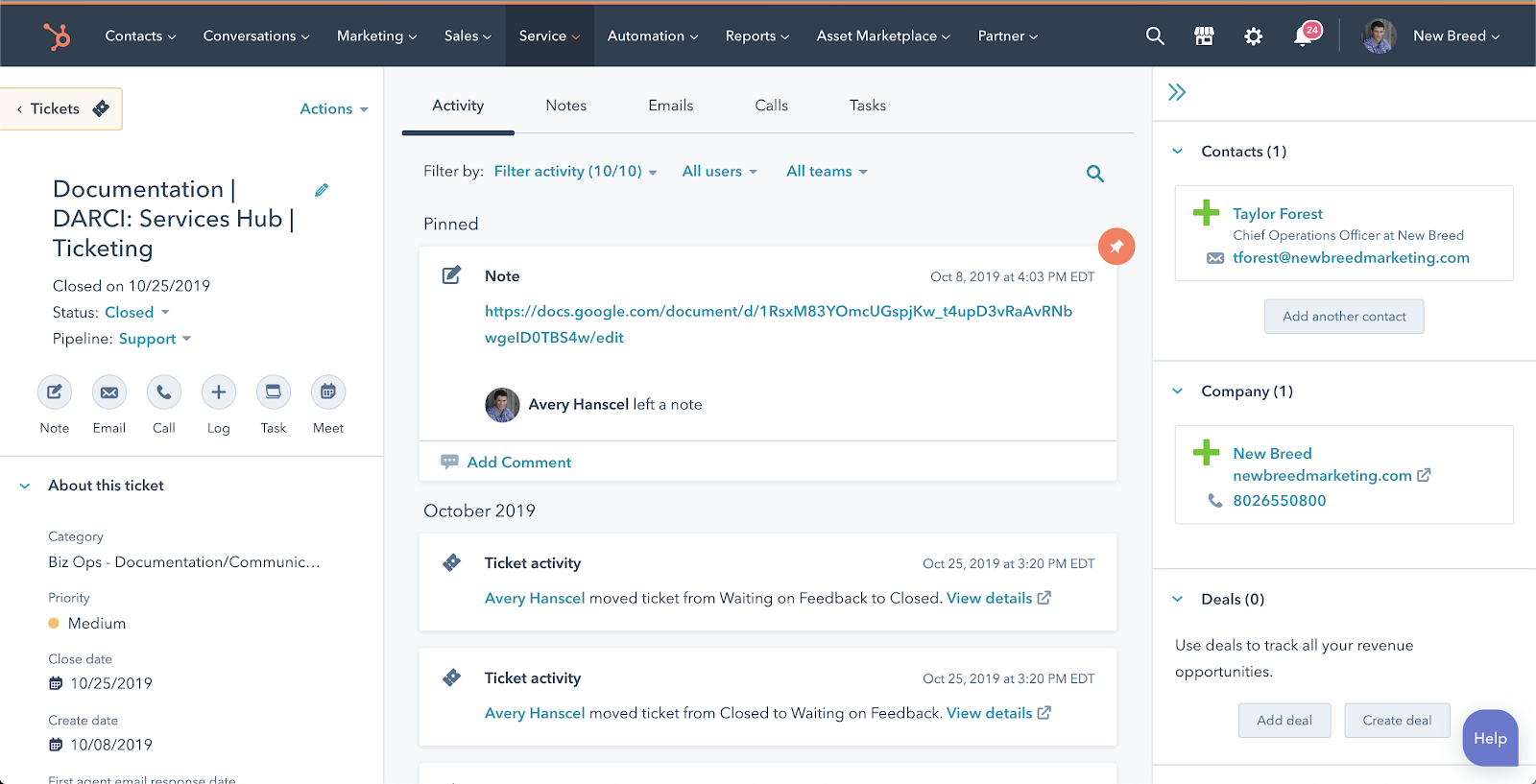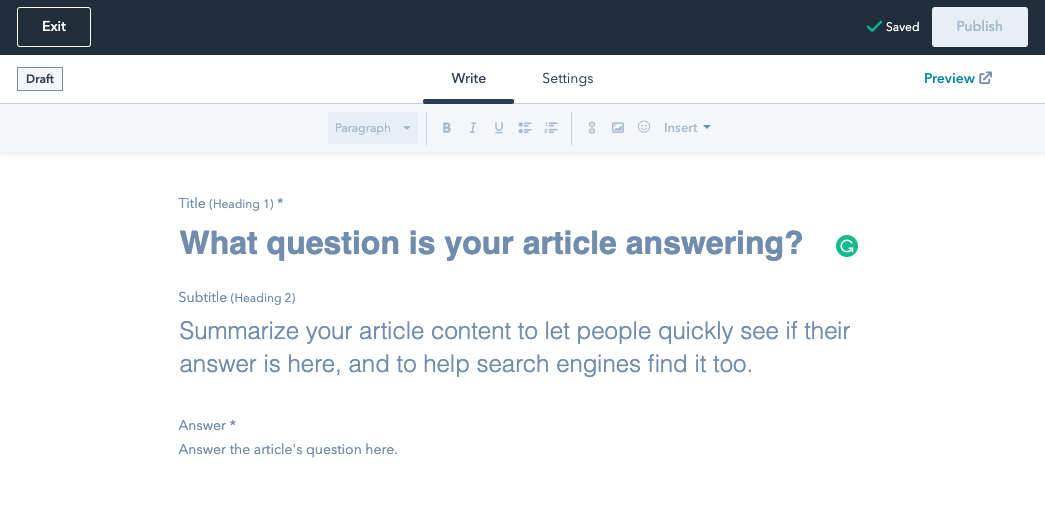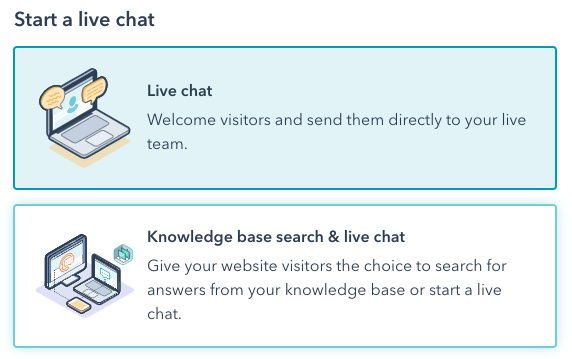.png?width=1200&name=Copy%20of%20Q3%20Blog%20Images%20(1).png)
If you’re thinking about the full revenue management lifecycle, which consists of marketing, sales and service, having the ability to manage all of those areas in one place breaks down silos and makes day-to-day life at a company easier.
The introduction of the HubSpot Service Hub enables companies to do just that.
The Marketing Hub helps you attract visitors and convert leads. The Sales Hub helps you nurture prospects and close deals. Now, the Service Hub helps you delight customers and transform them into promoters.
The Main Features of the Service Hub
Feedback surveys

One of the best ways to improve your product or service over time is to learn the value that your customers are gaining from it through implicit and explicit information. Feedback surveys allow you to collect that information.
The Service Hub’s feedback surveys tool allows you to collect feedback around customer support, satisfaction and loyalty. There are three types of surveys you can send: customer effort score, customer satisfaction and net promoter score.
CSAT: customer satisfaction surveys
Customer satisfaction surveys allow you to collect feedback about multiple aspects of your company. Instead of capturing your customers’ overarching impression of you, you can ask questions about specific products or services they use or specific interactions they’ve had.
For example, you could collect feedback about their onboarding process or how they feel after an update was rolled out to your product or service offering.
You can completely customize the question that survey recipients are asked, and they can respond that they’re happy, unhappy or neutral. Then they can add comments about why they feel that way. This enables you to get granular feedback about what’s working well for your customers — and what isn’t.
CES: customer support survey
After a support ticket is closed, you can send an automated survey about the support experience. You can choose for this survey to go out immediately once the ticket closes or set a delay.
The survey asks recipients to rate the ease of handling their problem on a scale of 1–7 and then provide feedback as to why they chose that rating.
This helps you understand how effective your ticket resolution process is and how customers feel about the service you provided during that process.
NPS: customer loyalty survey
Net Promoter Score (NPS) is a scale that allows companies to measure their customers’ willingness to recommend their products or services to others. Net Promoter, Net Promoter Score and NPS are registered trademarks of Bain & Company, Inc., Satmetrix Systems, Inc. and Fred Reichheld.
It’s calculated by asking the question “How likely are you to recommend [company or product] to a friend or colleague?”. Then respondents can choose a rating between 0 and 10.
The score calculated from those responses can help you understand how your existing customers are contributing to your company’s growth.
HubSpot presents your NPS results right in the survey tool, making it easy to analyze not just your overall score, but also your response rate without having to build a custom report.
Tickets

When something goes wrong and your customers need help, ensuring it’s easy for them to receive the support they need is vital for the health of your relationship.
A ticket system enables your customers to reach out with their issue and you to capture, manage and resolve tickets in a timely manner.
The Service Hub’s tickets tool lets you set up different pipelines for your tickets, so you can separate internal and external tickets or sort them across different teams or departments. This ensures that tickets can reach the right person.
Additionally, each ticket includes an entire record of the issue, and support team members can leave notes, create tasks and call or email people all from the ticket itself.
Knowledge base

A knowledge base is a resource library specific to your company’s product or service that offers self-service support for your customers. They help you provide your customers with the answers to commonly asked questions without bogging down your support team.
It’s very easy to create knowledge base articles and organize resources, and you don’t have to have any web development knowledge to do so.
The Service Hub’s knowledge base allows you to set permission-level at the page-level. That enables you to create resources that only customers and employees can see. You can get as specific with your page permissions as you are with your contact lists.
Since audience access is set for each article, you can create resources for different audiences and still host them in the same place without worrying someone will access information that’s not applicable to them. For example, you could host champion enablement resources, internal documentation and customer support articles all in the same place.
And, in case your knowledge base doesn’t provide someone with the answer they were looking for, you can include a support form in the top navigation, making it easy for them to submit a ticket.
Other Benefits of the Service Hub
Integration with the Conversations
The integration of the Service Hub with HubSpot Conversations means that not only do support requests go into the universal conversations inbox but also that you can utilize chat to reference your knowledge base and ticketing systems.

You can build support chatbots that can search for knowledge base articles and submit tickets on users’ behalf. You can also create live chats for your team members to communicate with site visitors directly.
Because live chat messages and support forms get sent to the conversations inbox, the burden of tracking all the communications doesn’t have to fall onto a single support rep.
Automation
Being able to use automation around the Service Hub tickets and feedback survey systems makes tools even more powerful.
Your marketers and sales representatives are already saving time on their mundane, routine tasks by setting up workflows and automating them. This frees up their workdays for the important activities of attracting visitors and closing customers.
Your customer service team can now also benefit from automation capabilities. For example, if someone responds to a customer satisfaction survey that they’re unhappy, you can automatically create a ticket to follow up with them.
You can also automate tickets and surveys around events that occur in the marketing and sales process. Like when a deal closes, you can enroll them into NPS survey lists and create tickets for your service team members to initiate outreach.
This helps close the loop between marketing, sales and service.
Reports
Each tool allows you to do some analysis and reporting within the tool, but you can also build reports around your surveys, tickets and knowledge base.
The report library has pre-built reports to help you understand the success of each of the service hub area too:
Tickets reports:
- Average ticket response time by source
- Ticket totals over time
- Ticket closed totals by rep
Customer feedback reports:
- Customer loyalty score (NPS) over time
- Feedback survey response totals by day
- Feedback survey response totals
- Feedback survey response comments
- Customer service score (CES) over time
Knowledge base reports:
- Knowledge base article total views over time
- Knowledge base articles with highest total views
Reporting across tickets, knowledge base and customer feedback should all work together. Ticket sources can help you understand which products or features present the most challenges to your customers. This can inform what knowledge base articles should be created to help them solve those challenges. Finally, customer feedback can provide general insight into whether or not the way you respond to tickets, distribute knowledge base articles and provide service to your customers is creating the intended experience.
The Takeaway
The HubSpot Service Hub enables you to increase alignment across the entirety of your company. By leveraging the entire HubSpot Growth Suite, you can break down the silos between marketing, sales and service and create a better experience for your customers.
Guido Bartolacci
Guido is Head of Product and Growth Strategy for New Breed. He specializes in running in-depth demand generation programs internally while assisting account managers in running them for our clients.





